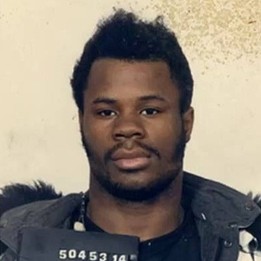
1966 - 2008
Larry Davis
Summary
Name:
Larry DavisNickname:
Adam Abdul-HakeemYears Active:
1983 - 1986Birth:
May 28, 1966Status:
DeceasedClass:
MurdererVictims:
1Method:
ShootingDeath:
February 20, 2008Nationality:
USA
1966 - 2008
Larry Davis
Summary: Murderer
Name:
Larry DavisNickname:
Adam Abdul-HakeemStatus:
DeceasedVictims:
1Method:
ShootingNationality:
USABirth:
May 28, 1966Death:
February 20, 2008Years Active:
1983 - 1986bio
Larry Davis was born on May 28, 1966, in New York City and grew up in the Bronx. As a teenager, he showed strong musical talent, playing instruments and dreaming of becoming a rapper. He ran small recording studios in the Bronx and Manhattan and was skilled at repairing motorcycles. Despite his artistic ambitions, Davis became involved in street-level drug dealing during his adolescence.
According to friends and later defense arguments, Davis’s involvement in drug trafficking was partly tied to corrupt police officers who allegedly sponsored young dealers. These claims suggested that Davis managed other dealers under police protection, and when he stopped cooperating and withheld drug proceeds, certain officers began threatening him. By the time Davis was in his early 20s, tensions with law enforcement had escalated.
Davis had a criminal record by 1983 and was convicted of robbery in 1984, later violating probation. Despite this, his peers described a turning point when his partner miscarried their child, allegedly due to drug use. Davis reportedly tried to leave the drug trade. In 1986, his daughter, Larrima Davis, was born.
That same year, Davis became entangled in allegations of murdering drug dealers and robbing narcotics spots. Police described him as a violent figure in a loosely organized group of gunmen targeting rival dealers. Davis, however, insisted he was being framed by rogue officers seeking to silence him over their own illegal drug operations.
murder story
On November 19, 1986, nine armed NYPD officers stormed the Bronx apartment of Davis’s sister, Regina Lewis, as part of a 27-officer raid. The police claimed they wanted to question Davis about multiple murders and drug-related crimes, though no arrest warrant had been issued. Davis, his girlfriend, his sister, and young children were inside the small apartment when the officers entered with shotguns and pistols drawn.
According to Davis and later trial testimony, police fired first, grazing his head with a shotgun round. Davis returned fire with a handgun in what he described as self-defense. In the ensuing gun battle, six officers were shot but survived. Amid the chaos, Davis escaped through another sister’s adjoining apartment and disappeared, triggering a 17-day citywide manhunt.
During this time, police linked Davis to earlier drug dealer killings, including the August 1986 murder of Raymond Vizcaino and the October killings of four Bronx drug dealers. Witness statements, ballistics tests, and Davis’s fingerprints connected him to these incidents, but Davis maintained his innocence and claimed police fabricated evidence.
On December 5, 1986, Davis was cornered in a Bronx apartment where he had forced entry. He briefly held a family hostage while negotiating with police over the phone. With heavy media coverage outside, Davis eventually surrendered peacefully the next morning, confident that police would not shoot him in front of cameras. Crowds of local residents reportedly cheered as he was taken away in handcuffs.
Over the next several years, Davis faced multiple trials:
March 1988: Acquitted of the October 1986 murders of four Bronx drug dealers. Defense attorney William Kunstler successfully argued that police fabricated evidence and tried to kill Davis during the raid to silence him about corruption.
November 1988: Acquitted of attempted murder and aggravated assault for shooting six officers during the 1986 raid. Davis was only convicted on weapons charges and sentenced to 5–15 years in prison.
December 1989: Acquitted of the September 1986 murder of Harlem drug dealer Victor Lagombra. Witnesses placed Davis in Florida during the killing.
March 1991: Convicted for the August 1986 murder of Raymond Vizcaino, a Bronx drug dealer. Davis and his brother Eddie were accused of attempting a robbery that led to Vizcaino’s shooting death. Davis received a sentence of 25 years to life, in addition to his earlier weapons conviction.
While incarcerated, Davis converted to Islam and adopted the name Adam Abdul-Hakeem. He continued to maintain his innocence, asserting that police corruption was responsible for his legal troubles. Over time, public perception of Davis remained divided: some viewed him as a folk hero who exposed systemic police misconduct, while others saw him as a violent criminal shielded by racial bias and anti-police sentiment.
On February 20, 2008, while serving his life sentence at Shawangunk Correctional Facility, Davis was fatally stabbed multiple times by fellow inmate Luis Rosado. Davis reportedly tried to defend himself with a cane but succumbed to his injuries after being rushed to a nearby hospital. Rosado later pleaded guilty to manslaughter and claimed Davis was not his intended target.
Larry Davis’s life and trials became symbolic of New York City’s turbulent 1980s, marked by drug wars, police corruption scandals, and public distrust of law enforcement. The 1990s Mollen Commission and later documentaries reignited debates over whether Davis was a victim of systemic corruption or a manipulative criminal exploiting public sentiment.